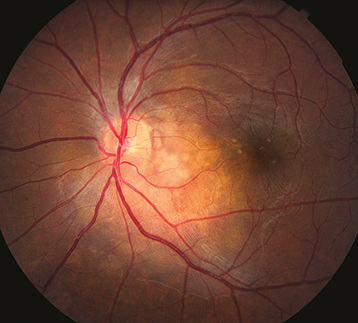CMV retinitis: Presents as a fulminant hemorrhagic necrosis, granular retinitis, or frosted-branch angiitis with minimal intraocular inflammation. See 12.12, Cytomegalovirus Retinitis.
Acute retinal necrosis (ARN). Most commonly secondary to VZV or HSV infection. Presents as large swaths of confluent retinitis that rapidly progresses and is typically associated with significant vitritis and anterior uveitis. See 12.13, Acute Retinal Necrosis.
PORN: Rapidly progressive herpetic outer retinal necrosis that occurs in immunocompromised patients, especially in advanced HIV/acquired immune deficiency syndrome (AIDS), with rapid involvement of the posterior pole and/or optic nerve over several days. Due to their immunocompromised status, it lacks significant signs of intraocular inflammation.
Bacterial endogenous endophthalmitis: Typically presents as a panuveitis, but more indolent bacteria can present with isolated posterior choroidal, subretinal, or retinal lesions alone. Lesions tend to be clustered in the posterior pole. See 12.17, Endogenous Bacterial Endophthalmitis.
TB: Most commonly bilateral multifocal, discrete, yellow lesions in the posterior pole. May be associated with optic nerve edema, vasculitis (classically a phlebitis, which may be occlusive). May present masquerading as tuberculosis serpiginous-like choroiditis.
Syphilis: Pleomorphic uveitis. Posterior placoid syphilis and punctate inner retinitis of syphilis are the more recognizable morphologies. See 12.10, Syphilis.
Candida endogenous endophthalmitis: Early discrete drusen-like choroidal lesions progressing to yellow-white, fluffy retinal, or preretinal lesions with a propensity for invading the vitreous cavity. See 12.18, Endogenous Fungal Endophthalmitis.
Aspergillus endogenous endophthalmitis: Early lesions resemble the feathered lesions of cotton-wool spots. Aspergillus has a propensity to invade the subretinal space.
Diffuse unilateral subacute neuroretinitis: Unilateral visual loss in children and young adults, caused by a subretinal nematode. Optic nerve swelling, vitreous cells, and deep gray-white retinal lesions are present initially but may be subtle. Later, optic atrophy, narrowing of retinal vessels, and atrophic RPE changes develop. Vision, visual fields, and electroretinogram deteriorate with time. Treatment is to laser the nematode. Antihelmintic drugs may be useful as adjunctive therapy.
Toxoplasmosis: Typically, unilateral retinal lesion which may or may not be associated with an adjacent pigmented chorioretinal scar. Associated with a dense vitritis over an area of white retinitis creating the classic “headlight in a fog” appearance See 12.9, Toxoplasmosis.
Sarcoidosis: Focal or multifocal initially creamy-appearing choroidal granulomas that progress to atrophic punched-out appearing lesions. May also be associated with optic nerve granulomas, retinal vasculitis (classically a phlebitis with “candle-wax drippings”) which may be occlusive and complicated by peripheral retinal neovascularization (see Figure 12.3.1).
White dot syndromes: See 12.8, White Dot Syndromes.
Autoimmune retinopathy: Subacute bilateral, but may be asymmetric; peripheral then central vision loss. OCT often shows progressive outer retinal loss. There is typically minimal vitritis or vasculitis. Late-stage findings include optic nerve pallor, macular edema, and retinal pigmentary changes.
Vitreoretinal lymphoma: Retinal findings include most commonly sub-RPE deposits that can be migratory in nature, leaving outer retinal and RPE atrophy in its wake. May be associated with vitreous cells.
Neuroretinitis: Unilateral stellate macular exudates, optic nerve swelling, and vitreous cells. Classically caused by B. henselae (“cat-scratch disease”), but can also be caused by other etiologies including syphilis, sarcoidosis, Lyme disease, TB.
